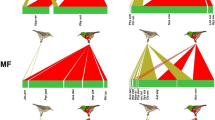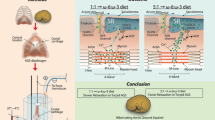Summary
Male golden-mantled ground squirrels were captured in the field in late summer and placed on either unlimited or restricted (80% normal) food rations in the laboratory until each animal began to hibernate. At entrance into hibernation mean body mass was 274.5 g for the unlimited group and 224.5 g for the restricted group. Only six of 21 males subsequently underwent reproductive maturation during winter. Each of these six received the unlimited ration prior to hibernation, and these six included the five heaviest animals in the experiment. In addition to activating their reproductive systems, these heavier squirrels began hibernation later and ended hibernation earlier than the lighter squirrels. Squirrels that remained reproductively quiescent averaged 25.5% body mass as fat in early spring and thus were not severely limited in energy stores during winter.
In another experiment a group of 13 male and female squirrels were housed together in a common outdoor enclosure in order to examine the possible relationship between reproductive condition and social standing of males. Although there appeared to be a social hierarchy among males, each male fattened substantially in fall and became reproductively active during winter.
These results suggest that the level of energy stores accumulated as fat prior to hibernation in fall affects the potential of male ground squirrels to breed in spring. This dependence of reproductive development on energy stores may reflect the high energetic costs associated with breeding in males when they emerge from hibernation in spring when food availability is low.
Similar content being viewed by others
References
Barnes BM (1983) Reproductive endocrinology of the goldenmantled ground squirrelSpermophilus saturatus. PhD dissertation, University of Washington, Seattle, Washington
Bronson MT (1977) Altitudinal variation in the annual cycle and life history of the golden-mantled ground squirrelSpermophilus lateralis. PhD dissertation, University of California, Berkeley, California
Bronson MT (1979) Altitudinal variation in the life history of the golden-mantled ground squirrel (Spermophilus lateralis). Ecology 60:272–279
Davis DE (1976) Hibernation and circannual rhythms of food consumption in marmots and ground squirrels. Q Rev Biol 51:477–506
Hall ER (1981) Mammals of North America, 2nd edn. Wiley, New York
Hall V, Goldman BD (1980) Effects of gonadal steroid hormones on hibernation in the Turkish hamster (Mesocricetus brandti). J Comp Physiol 135:107–114
French AR (1982) Innaspecific differences in the patterns of hibernation in the ground squirrelSpermophilus beldingi. J Comp Physiol 148:83–91
Kenagy GJ (1979) Rapid and repeatable surgical technique for measurement of testis size in small mammals. J Mamm 60:636–638
Licht P, Zucker I, Hubbard G, Boshes M (1982) Circannual rhythms of plasma testosterone and luteinizing hormone levels in golden-mantled ground squirrels. Biol Reprod 27:411–418
McKeever S (1964) The biology of the golden-mantled ground squirrel,Spermophilus lateralis. Ecol Monogr 34:383–401
Michener GR (1977) Effect of climatic conditions of the annual activity and hibernation cycle of Richardson's ground squirrels and Columbian ground squirrels. Can J Zool 55:693–703
Michener GR (1983) Kin identification, matriarchies, and the evolution of sociality in ground-dwelling sciurids. In: Eisenberg JF, Kleiman DG (eds) Recent advances in the study of mammalian behavior. Am Society Mamm, Special Publ 7:528–566
Morton ML (1975) Seasonal cycles of body weights and lipids in Belding ground squirrels. Bull Soc Cal Acad Sci 74:128–143
Morton ML, Gallup JS (1975) Reproductive cycle of the Belding ground squirrel (Spermophilus beldingi beldingi): seasonal and age differences. Great Basin Nat 35:427–433
Mullally DB (1953) Hibernation in the golden-mantled ground squirrelCitellus lateralis bernardinus. J Mamm 34:65–73
Phillips J (1981) Growth and its relationship to the initial annual cycle of the golden-mantled ground squirrel. Can J Zool 59:865–871
Shaw WT (1925) The seasonal differences of north and south slopes in controlling the activities of the Columbian ground squirrel. Ecology 6:157–162
Slade NA, Balph DF (1974) Population ecology of Uinta ground squirrels. Ecology 55:989–1003
Wingfield JC, DS Farner (1975) The determination of five steroids in avian plasma by radioimmunoassay and competitive protein binding. Steroids 26:311–327
Wirtz JH (1967) Social dominance in the golden-mantled ground squirrel,Citellus lateralis chrysodeirus (Merriam). Z Tierpsychol 24:342–350
Author information
Authors and Affiliations
Rights and permissions
About this article
Cite this article
Barnes, B.M. Influence of energy stores on activation of reproductive function in male golden-mantled ground squirrels. J Comp Physiol B 154, 421–425 (1984). https://doi.org/10.1007/BF00684449
Accepted:
Issue Date:
DOI: https://doi.org/10.1007/BF00684449




